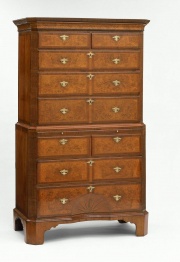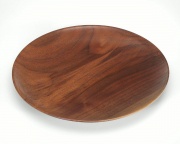Black walnut
Description
A tall deciduous walnut tree, Juglans nigra, native to eastern and mid-western sections of North America. The black walnut tree has strong, durable, dark brown heartwood that finishes to a high polish. The sapwood is a pale yellow. The texture is coarse, but uniform and the grain is usually straight. Variations in color and waviness in grain are usually valued for decorative work. Black walnut is used for paneling, interior trim, furniture, cabinetry, clocks, propellers, gunstocks, sewing machines, piano cases, plywood, veneer, and decorative items. The nuts of the black walnut tree are edible. A dark brown dye is made from the nut husks and tree leaves. A drying oil obtained from pressing the nut kernel is used for artists' paints. Powdered walnut shells are used as a filler in plastics.
Synonyms and Related Terms
Juglans nigra; noyer americain (Fr.); Schwartznüss (Deut.); Amerikanischer Nüssbaum (Deut.); noce nero d'America (It.); nogal negro Americano (Esp.); Sort Valnød (Dan.); nogueira preta (Port.); American walnut; Queen Ann's cabinet wood; gumwood
For black walnut fiber identification see http://cameo.mfa.org/wiki/Category:FRIL:_Black_Walnut
Physical and Chemical Properties
- Large tree growing to 35 m with straight trunk and narrow crown.
- Bark=brown with ridges and furrows in diamond pattern.
- Leaves=Pinnates with 10-24 leaflets (8 cm long)
- Fruit=round nut in green husk; matures early fall.
- Chocolate brown wood is hard and heavy.
- Rings=distinct.
- Pores=coarse, diffuse.
- Grain=faint.
- Rays=visible
- Wood has low acidity.
- Distinctive mild, gum-like taste; aromatic smell.
- Density = 40-50 ppcf
- Specific gravity = 0.66
Additional Images
Resources and Citations
- Palmy Weigle, Ancient Dyes for Modern Weavers, Watson-Guptill Publications, New York, 1974
- F. H. Titmuss, Commercial Timbers of the World, The Technical Press Ltd., London, 1965
- John and Margaret Cannon, Dye Plants and Dyeing, Herbert Press, London, 1994
- Hardwood Manufacturers Institute, Memphis Tenn.: air-dry weight = 39 pcf
- Edward Reich, Carlton J. Siegler, Consumer Goods: How to Know and Use Them, American Book Company, New York City, 1937
- Virginia Tech Dendrology website at www.fw.vt.edu/dendro/dendrology/main.htm (accessed Oct. 8, 2005)
- Wikipedia: http://en.wikipedia.org/wiki/Black_Walnut (Accessed Oct. 8, 2005)
- G.S.Brady, Materials Handbook, McGraw-Hill Book Co., New York, 1971 Comment: p. 856
- Ralph Mayer, A Dictionary of Art Terms and Techniques, Harper and Row Publishers, New York, 1969 (also 1945 printing)
- Pam Hatchfield, Pollutants in the Museum Environment, Archetype Press, London, 2002
- Dictionary of Building Preservation, Ward Bucher, ed., John Wiley & Sons, Inc., New York City, 1996
- Random House, Webster's Encyclopedic Unabridged Dictionary of the English Language, Grammercy Book, New York, 1997
- The American Heritage Dictionary or Encarta, via Microsoft Bookshelf 98, Microsoft Corp., 1998
- Gordon Hanlon, contributed information, 1998








